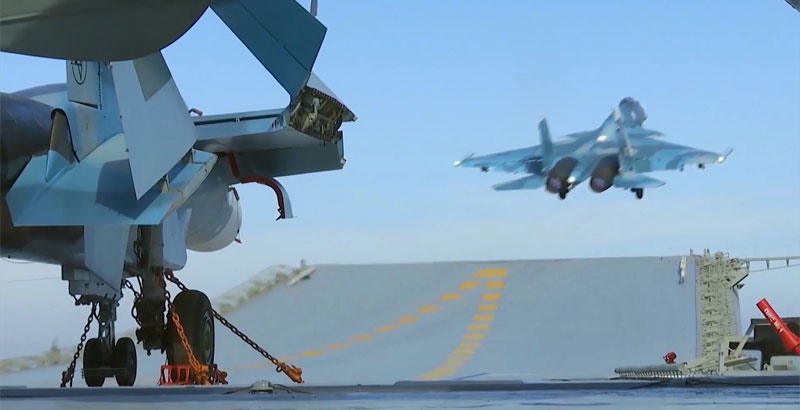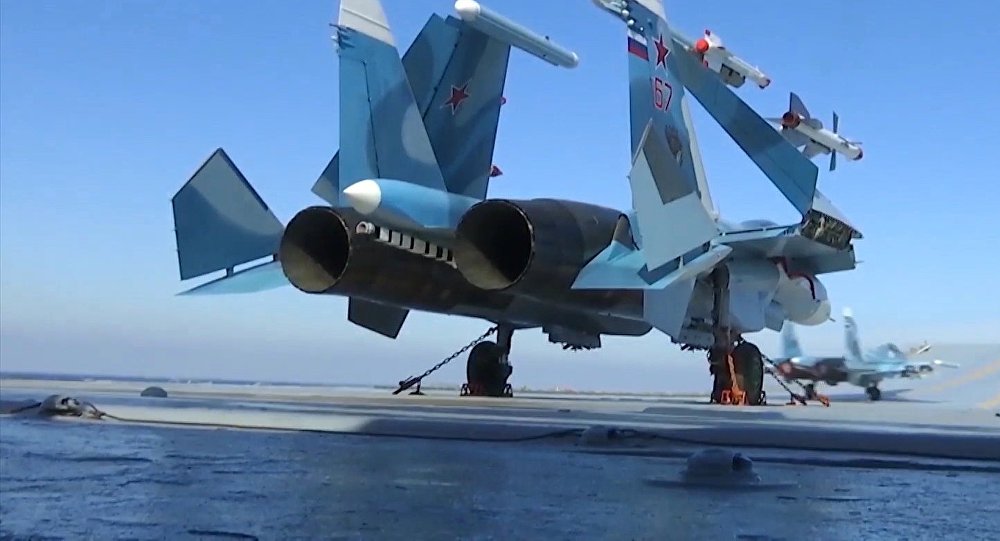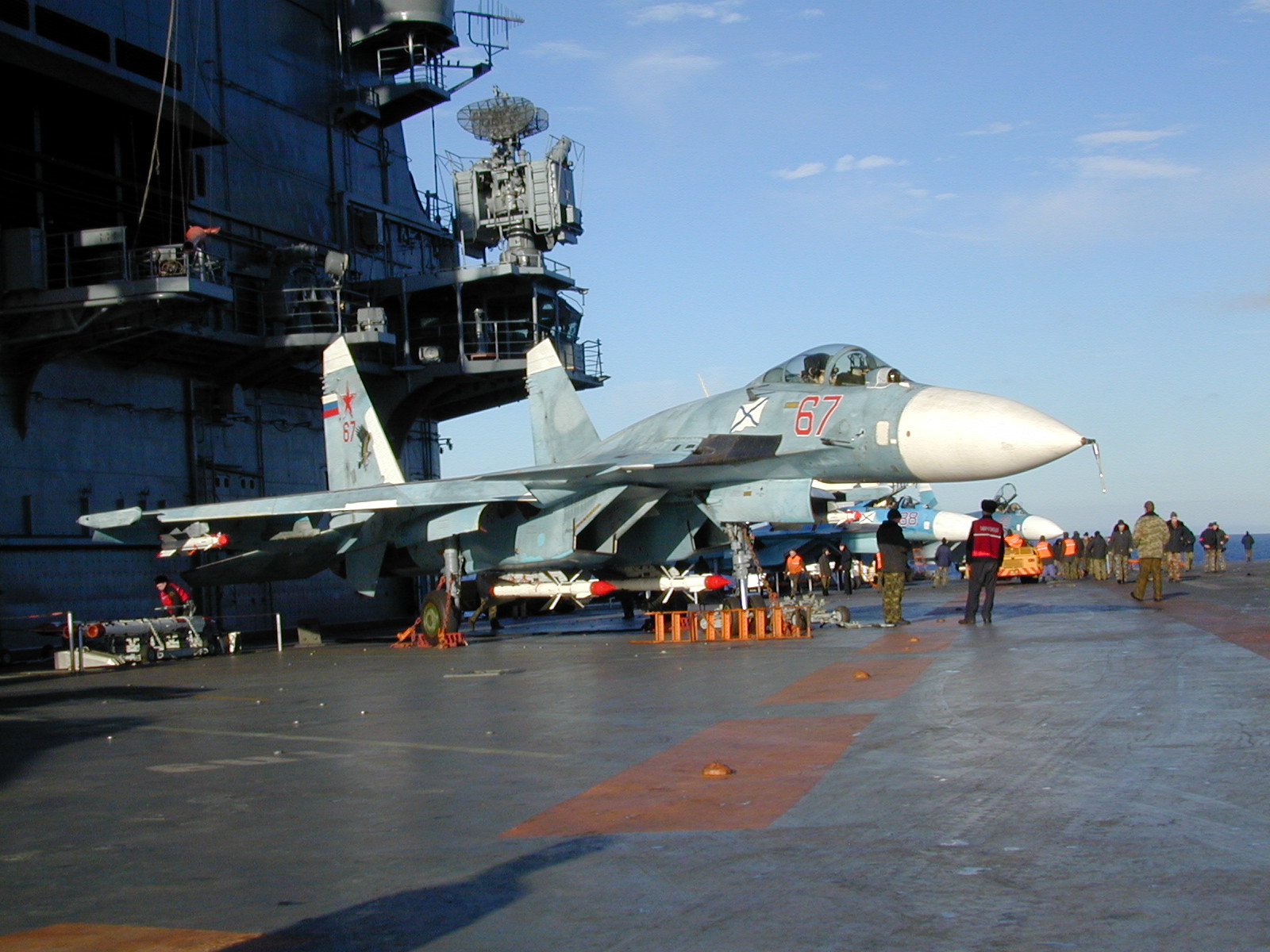According to preliminary data, breakage of an arresting wire occurred due to a pilot’s error.

The Su-33 is taking off from the deck of the Admiral Kuznetsov heavy aircraft-carrying missile cruiser near the Syrian shores in the Mediterranean, November 2016 (Photo: RIA Novosti / Russian Defense Ministry)
The main version of a reason of an incident with the Su-33 fighter jet, which fell from a deck of the Admiral Kuznetsov heavy aircraft-carrying missile cruiser in the Mediterranean Sea on December 3, has appeared.
According to preliminary data, breakage of an arresting wire occurred due to a pilot’s error. Experts believe that a pilot of the aircraft surpassed the maximum allowable variance on a runway centerline, creating in this way an overload of the arresting wire. It was found that the variance on a runway centerline of the fighter jet was exceeded by almost half a meter from the maximum allowable (4.7 meters instead of 4.2 meters).
As a result of the accident, the Su-33 with the tail number ‘67 Red’ was lost.
We call attention to the fact that this version is currently informal. Moreover, the Russian Defense Ministry said that “the information about the allegedly ‘preliminary’ findings of a commission of investigation of reasons of the crash of the Su-33 fighter jet is not true.”
However, sources close to the General Staff of the Russian Navy claim that results of the study of materials of the objective control allowed to recreate the accident picture.
On that day, the aircraft of the 279th separate ship-based fighter aviation regiment (the tail number ‘67 Red’), which was a part of the Admiral Kuznetsov’s aviawing, carried out its combat mission on the territory of Syria and was returning on a board of the cruiser. The flight conditions were rated as good: mild excitement, good visibility up to 10 km and wind was not more than 12 knots. At first, everything was in routine mode: an air traffic manager, who was at the command and control centre of the vessel, gave the pilot permission to land, and the latter started to execute the maneuver.
The aircraft hooked the arresting wire with a barrier hook and started to reduce engine rotational rate. The Su-33 made a way at a distance about 50 meters, then the arresting wire broke, and, instead to stop on the deck, the aircraft continued to move. The pilot already did not have time to turn on the afterburner and make an attempt to go-around. After a few seconds, the air traffic manager ordered the pilot to catapult, and the latter did this immediately. The aircraft itself came crashing down into the sea from the deck.
An assumption, which was made earlier and according to which the fighter jet exceeded the speed at the moment of the landing, did not find confirmation (the Su-33 landed at the allowable speed of 240 km per hour).
Will remind, earlier, the Admiral Kuznetsov lost the MiG-29.

The Su-33 with the tail number ‘67 Red’ (Photo: Russian Defense Ministry)

The Su-33 with the tail number ‘67 Red’ (Photo: Russian Defense Ministry)






Was the aircraft recovered? I don’t know how complicated the arresting
system is. Perhaps someone can explain if the problem can be easily
rectified.
Think they sink reasonably quickly in water after pilot ejects, as open cockpit fills with water, as do air intakes underneath, that both drag it downward. Would need a crane barge on immediate standby with divers ready to go, to rig salvage lines and floats, to recover it, and would be insanely dangerous work on a sinking aircraft. Shame though, as beautiful aircraft.
Arresting systems are very complex. Stopping an aircraft with that much energy is no easy task.
It still sounds weird, and not just because the translation of this article seems to have been carried out by Google Translate. An arresting wire breaking has the potential to thrash about like a whip across the ship’s deck, destroying everything in its path and killing everyone caught in its way.
I’m not sure but believe it depends on the tension, it’s not something that would happen all the times.
There is a rumor that suggests that it was Israeli electronic interference that was responsible for both aircraft lost on the Russian aircraft carrier.
it happens https://www.youtube.com/watch?v=EX19sAudmic
https://www.youtube.com/watch?v=hYRrObh0BNE
The Washington Post has already blamed this on Trump